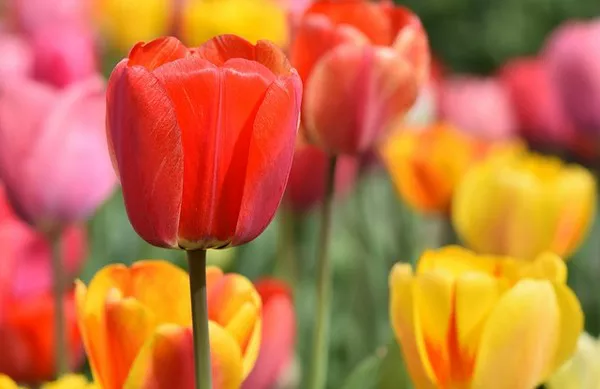Tulips, with their vibrant hues and delicate petals, are among the most beloved flowers worldwide. Originating from Central Asia and cultivated extensively in the Netherlands, these beauties have captured the hearts of gardeners and florists alike. While tulips are adored for their ephemeral beauty in gardens and floral arrangements, preserving their splendor through drying offers a means to enjoy them for months beyond their blooming season. In this comprehensive guide, we delve into the art of drying tulip flowers, exploring the factors influencing the drying process, various drying methods, and essential tips for achieving optimal results.
Factors Affecting the Drying Effect of Tulip Flowers
Successful drying of tulip flowers hinges on understanding the factors that influence the process. Several key variables impact the outcome, including:
1. Stage of Bloom: The stage at which tulips are harvested significantly affects their drying success. Flowers at their peak bloom, with petals just beginning to unfurl, are ideal candidates for drying. Harvesting too early or too late can result in subpar drying outcomes.
2. Environmental Conditions: The environment in which tulips are dried plays a crucial role in the process. Optimal conditions include low humidity, good air circulation, and moderate temperatures. Excessive moisture in the air can lead to mold and decay, while high temperatures may cause rapid wilting.
3. Preparation Techniques: Proper preparation prior to drying can enhance the longevity and aesthetics of dried tulips. This includes removing excess foliage, trimming stems to desired lengths, and treating flowers with a floral preservative solution to maintain color and structure.
4. Drying Method: The method chosen for drying tulip flowers greatly impacts the final result. From air-drying to silica gel and pressing, each technique offers unique advantages and considerations.
Methods of Drying Tulip Flowers
1. Air-Drying:
Air-drying is one of the simplest and most accessible methods for drying tulip flowers. To air-dry tulips, gather them into small bunches and secure the stems with twine or rubber bands.
Hang the bunches upside down in a cool, dry, and well-ventilated area, such as a darkened room or a garage. Ensure that the flowers are not overcrowded, allowing for ample airflow between blooms.
Depending on environmental conditions, tulips typically dry within two to three weeks. Once fully dried, they can be used in floral arrangements, wreaths, or decorative displays.
2. Silica Gel Drying:
Silica gel offers a fast and effective method for drying tulip flowers while preserving their natural color and shape. Begin by preparing a container deep enough to accommodate the tulips without crowding.
Pour a layer of silica gel into the bottom of the container, then gently place the tulips on top, ensuring that they are not touching each other or the sides of the container.
Carefully cover the tulips with additional silica gel until they are completely submerged. Seal the container with an airtight lid and allow the flowers to dry for three to five days.
Once dried, carefully remove the tulips from the silica gel and brush off any excess crystals. Silica gel-dried tulips are well-suited for arrangements and crafts, retaining their shape and color for an extended period.
3. Pressing:
Pressing is an excellent method for preserving the delicate beauty of tulip blooms, particularly for use in botanical art and crafts. To press tulips, select blooms that are at their peak freshness.
Place the tulips between layers of absorbent paper, such as blotting paper or parchment, ensuring that they are spaced apart to prevent overlapping.
Place the layered tulips within the pages of a heavy book or a flower press, applying gentle pressure to flatten the blooms. Leave the tulips to press for two to four weeks, periodically replacing the absorbent paper as needed.
Once fully pressed and dried, the tulips can be used to create stunning pressed flower arrangements, greeting cards, or framed botanical art pieces.
Tips for Drying Tulip Flowers
1. Harvest at the Right Time: Choose tulips for drying when they are at their peak bloom, with petals just beginning to unfurl. Avoid harvesting flowers that are fully open or beginning to wilt.
2. Handle with Care: Handle tulips gently during the drying process to prevent damage to the delicate petals and stems. Avoid excessive handling or squeezing, which can cause bruising or browning.
3. Maintain Ideal Conditions: Create a suitable drying environment with low humidity, good air circulation, and moderate temperatures. Check the drying area regularly for signs of mold or decay, and make adjustments as needed.
4. Experiment with Techniques: Explore different drying methods, such as air-drying, silica gel, and pressing, to discover which yields the best results for your preferences and intended use.
5. Preserve Natural Color: To maintain the vibrant color of dried tulips, consider treating the flowers with a floral preservative solution or a clear aerosol sealer after drying.
6. Store Properly: Once dried, store tulip flowers in a cool, dry place away from direct sunlight to prevent fading or discoloration over time. Use airtight containers or sealed bags to protect the flowers from moisture and dust.
Conclusion
In conclusion, drying tulip flowers offers a delightful way to extend their beauty and enjoy them long after their bloom has faded. By understanding the factors influencing the drying process, choosing appropriate methods, and following essential tips, enthusiasts can preserve the elegance of tulips for various decorative and artistic endeavors. Whether air-dried, preserved in silica gel, or pressed for botanical art, dried tulips add a touch of timeless charm to floral arrangements, crafts, and home décor.


